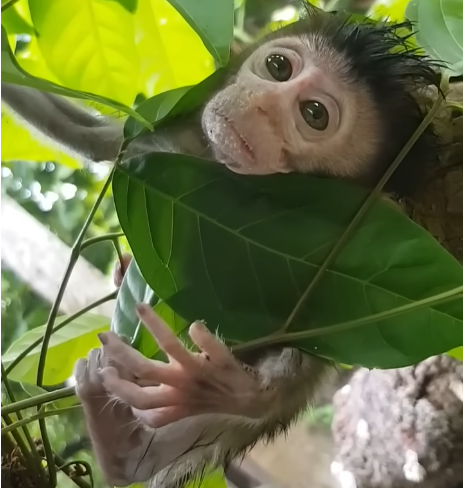
In the heart of Banana Grove, where the trees swayed like dancers and sunlight filtered through endless green, lived a young monkey named Tiko. He was smaller than most in his troop, with wide, curious eyes and a belly that always seemed just a little too round. But what made Tiko truly special wasn’t his size or his clumsy leaps — it was his nature.
Tiko was friendly. Exceptionally friendly.
While most monkeys were wary of outsiders — especially the strange, two-legged creatures with cameras and fruit baskets — Tiko was different. He would scamper right up to humans without hesitation, his head tilted with interest and his tiny hands stretched out as if in greeting.
Tourists who visited the edge of the grove often found themselves charmed by this little ball of fur. Tiko would approach with no fear, hopping onto their shoulders or sitting beside them on a bench like an old friend. He’d inspect hats, nibble gently at shoelaces, and steal grapes with such innocent precision that no one ever seemed to mind.
The locals had a dozen names for him: “Little Ambassador,” “Jungle Welcomer,” “The Mayor of Banana Grove.” Children giggled at his antics. Elders warned, half-seriously, “Don’t let him follow you home — he might never leave!”
Tiko didn’t just charm people. Birds would land near him. Squirrels would share snacks. Even the grumpy old boar who chased everyone away from the watering hole let Tiko sit beside him once. There was something calming about his presence — as if he had no interest in dominance or rivalry, only connection.
One day, a small group of hikers entered the grove, new to the area and unaware of the grove’s friendly resident. As they wandered deeper, one of them, a girl named Lina, sat on a mossy stone to catch her breath. Within moments, Tiko appeared. He circled her twice, curious but unafraid, before climbing up onto her backpack and tugging playfully at the zipper.
Startled at first, Lina quickly relaxed. Tiko’s soft chattering and relaxed posture made it clear — he was saying hello.
Her friends pulled out their phones and began snapping photos, laughing as Tiko struck pose after pose. He held out a half-eaten fig like a gift. He climbed up Lina’s arm, sat on her shoulder, and gently patted her head. For the rest of the hike, he followed them — not as a guide, but as a new friend, occasionally darting ahead to pick up shiny pebbles or grab fallen fruit.
That evening, as the group prepared to leave, Tiko stood quietly at the edge of the grove. He didn’t beg or protest. He simply watched, blinking slowly, as if to say, “It was nice meeting you.”
Lina turned back for one last look and waved. “Thank you, little guy,” she said. Tiko gave a small hop and disappeared into the underbrush.
News of the “approachable monkey” spread far beyond the village. People came from towns away just to catch a glimpse of him. Wildlife researchers took notes. Documentarians filmed his interactions, amazed at how social he was — not just with his own kind, but with every creature around him.
But despite the growing fame, Tiko never changed. He remained the same sweet, curious soul who simply liked making friends. He still sat with tired travelers, shared stolen fruits with younger monkeys, and occasionally napped in the sun beside the old boar.
He wasn’t just a monkey — he was a symbol. A reminder that connection can cross boundaries of language, species, and fear. In a jungle ruled by instinct and survival, Tiko was proof that kindness, too, has a place.


